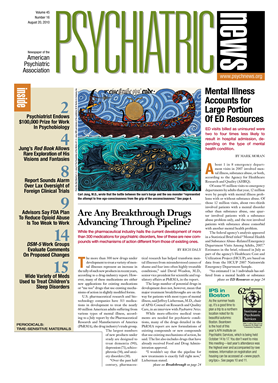From February to April, the
DSM-5 work groups posted their proposed changes on a public Web site—at <
www.dsm5.org>—and more than 8,600 people took advantage of the opportunity to submit comments.
One reason that the DSM-5 Task Force decided to post proposed changes suggested by the various work groups was to give APA members, mental health professionals, mental health advocates, patients and their families, as well as the general public the opportunity to see where the future of psychiatric diagnosis is headed and to inform them about the DSM-5 revision process. Another reason was to give the public a chance to comment on the proposed changes.
The 13 DSM-5 work groups have now evaluated these comments, and summaries of their evaluations are contained in a report titled “Compilation of Summaries of Planned Changes to Proposed Criteria, Based on Web Site Commentary.”
The report will soon be posted online at <
www.dsm5.org>, Darrel Regier, M.D., M.P.H., told
Psychiatric News. In addition to being vice-chair of the
DSM-5 Task Force, Regier is director of APA's Division of Research and executive director of the American Psychiatric Institute for Research and Education.
In the report, the DSM-5 work groups noted that many of the comments they received on the Web site were thoughtful and constructive.
Asperger's Proposal Controversial
For example, the DSM-5 Neurodevelopmental Disorders Work Group received nearly 2,000 comments, considerably more than any other work group. Much of the interest seemed to have been generated by a New York Times article discussing the work group's recommendation to merge Asperger's disorder into the broader diagnosis of autism spectrum disorder. Many people who commented opposed such a change.
Some were concerned about loss of insurance coverage and benefits, or loss of focused Asperger's care, if the diagnoses were merged. Others insisted that Asperger's patients should have a distinct diagnosis because Asperger's often occurs in highly intelligent people, whereas autism sometimes is associated with intellectual deficits, or because Asperger's is now widely known in society, which gives individuals with the condition a sense of identity and a basis for advocacy.
The Sexual and Gender Identity Disorders Work Group received more than 800 comments on its proposals. Many were from transgender individuals who wanted to see transgender disorder dropped from DSM. Others were from professionals or advocates for transgender people who wanted to see the disorder retained in DSM so that transgender individuals would have easy access to health services pertinent to their transgender identity.
Proposed changes to anxiety disorder criteria also received a considerable number of comments, with many respondents expressing support for the proposal that skin-picking, hoarding, and agoraphobia should be independent, codable disorders, a proposal the work group focused on anxiety disorders is considering.
Possible Revisions in Proposed Changes
Any changes made in DSM, of course, must be based on science. But after evaluating the comments received from the public, some of the DSM-5 work groups indicated that they may alter proposed changes.
For example, the Child and Adolescent Disorders Work Group received many comments from professional and medical societies and academic researchers about a proposed new disorder—temper dysregulation disorder with dysphoria. Although the comments ran about 2 to 1 in favor of the proposal, the name of the disorder was criticized because it was too close to children's temper tantrums. The work group thus decided to seek a more appropriate name for the condition.
The Mood Disorders Work Group had proposed including a suicide-assessment guide in the DSM-5 section concerning mood disorder diagnoses. This proposal received both supportive and critical comments from psychiatrists, mental health professionals, and patients. The work group noted in the report that these comments helped it rethink how it is going to present the guide.
In other instances, the work groups considered the public's recommendations, but ultimately decided against adopting them, they noted in the report.
For example, in response to the suggestion that cognitive deficits be included as a criterion for the diagnosis of schizophrenia, the Psychosis Work Group discussed the issue at length and determined that there is insufficient research evidence for specificity to schizophrenia to warrant the use of cognitive deficits as a diagnostic criterion—that is, cognitive deficits are present in many disorders, not just in schizophrenia.
Field Trials Come Next
The next phase of DSM-5 development will be to conduct field trials to test the reliability and usefulness of proposed changes to DSM. The trials will focus on a number of issues, including changes to diagnostic criteria, proposals for new disorders, and the use of dimensional assessments to capture broad symptoms and the severity of symptoms.
“Dimensional assessments are a new approach for DSM, and the field trials will examine whether gathering such information from patients is helpful for making diagnoses and in planning treatment,” Regier told Psychiatric News. “The field trials will also help us learn whether clinicians find such assessments easy to use, especially in busy clinical settings.”
The field trials are scheduled to begin in September.

